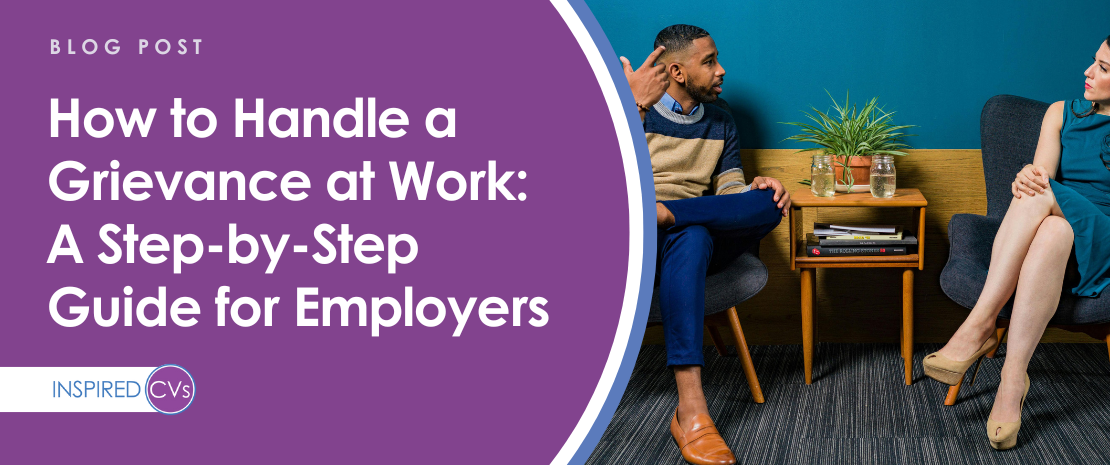Get in touch
For a quick chat or more information about our services, get in touch:

When employees raise concerns in the workplace, it’s essential for employers to take these issues seriously and handle them through a clear and fair grievance procedure. Managing employee grievances professionally not only helps resolve disputes quickly but also strengthens trust and improves overall employee relations.
This guide outlines the types of workplace grievances, how to manage a formal grievance from start to finish, and the key steps you should follow as an employer or HR professional.
✅ Why Having a Grievance Procedure Matters
A documented grievance policy ensures that employees understand how to raise concerns formally. It also protects employers by ensuring there is a fair and transparent process for handling workplace complaints, which can include issues related to:
Discrimination or harassment
Poor working conditions
Unfair treatment
Management behaviour
Breakdowns in communication
When these issues go unaddressed, they can escalate, negatively affecting employee morale, productivity, and even increasing the risk of legal claims.
🛠️ Step 1: Encourage Informal Resolution First
Most employees will attempt to resolve concerns informally with their line manager. This is often the quickest and least confrontational way to handle workplace issues.
However, if the issue isn’t resolved or the employee feels they’re not being heard, they may escalate the matter and submit a formal grievance.
📝 Step 2: Submitting a Formal Grievance Letter
The first step in the formal grievance process is for the employee to submit a written grievance letter. This creates a record of the complaint and ensures that the matter is taken seriously.
📄 Example Grievance Letter Template (as recommended by ACAS):
[Today’s date]
Dear [Manager / HR Representative],
I am writing to raise a formal grievance.
I have a complaint regarding [briefly explain the issue].
[Optional] I have supporting evidence including [e.g., emails, messages, witness statements].
[Optional] I would like the following outcome: [state desired resolution].
Please let me know when we can meet to discuss this. I would also like to be accompanied at the meeting by [name].
Yours sincerely,
[Employee’s name]
🤝 Step 3: Holding the Grievance Meeting
Once the grievance letter is received, you should arrange a grievance meeting as soon as possible. This is an opportunity for the employee to present their case, explain their concerns in more detail, and provide any evidence they have.
💡 Best Practices for Grievance Meetings:
Allow the employee to bring a colleague or trade union representative
Maintain confidentiality throughout
Keep detailed notes of the discussion
Stay impartial and professional
Be open to listening without interrupting
Let the employee know when to expect a decision
If the employee has a disability, ensure that reasonable adjustments are made to accommodate their needs.
🔍 Step 4: Conducting a Grievance Investigation
After the grievance meeting, you should conduct a thorough and unbiased grievance investigation. This may include:
Speaking with the employee’s manager or anyone named in the grievance
Reviewing documents or communication relevant to the complaint
Interviewing any witnesses
📌 Example:
If an employee raises a grievance about not receiving promised overtime pay, your investigation might involve:
Speaking to the manager about the claim
Reviewing timesheets and payroll records
Checking for any written communications confirming the overtime agreement
🧾 Step 5: Making a Decision and Communicating the Outcome
Once the investigation is complete, use all available information to make a fair decision. Communicate the outcome to the employee in person (where possible), and follow up with a written grievance outcome letter.
Your letter should include:
A summary of the grievance
The investigation findings
The outcome and any action to be taken
The employee’s right to appeal the decision
📢 Step 6: Appeals Process
If the employee disagrees with the outcome, they have the right to appeal the grievance decision. Your grievance policy should clearly outline how and when appeals must be submitted, and a separate person should ideally handle the appeal to ensure impartiality.
📌 Key Takeaways for Employers
Always take employee concerns seriously
Encourage informal resolution first, but provide a clear formal grievance process
Keep the process fair, transparent, and well-documented to avoid employment tribunals
Maintain confidentiality and impartiality throughout
Understand your obligations under employment law
🤝 Need Help Managing Grievances in Your Workplace?
At Inspired CVs, we provide expert HR support for employers, including guidance on grievance procedures, formal investigations, and employee relations. Whether you're responding to an employee complaint or updating your HR policies, our experienced team can help you navigate the process with confidence. We also provide professional CVs if you’re looking for your next move and CV and interview workshops.
📞 Contact us today for tailored HR advice, or explore our services for HR documentation, employee management, and workplace dispute resolution.
For a quick chat or more information about our services, get in touch: